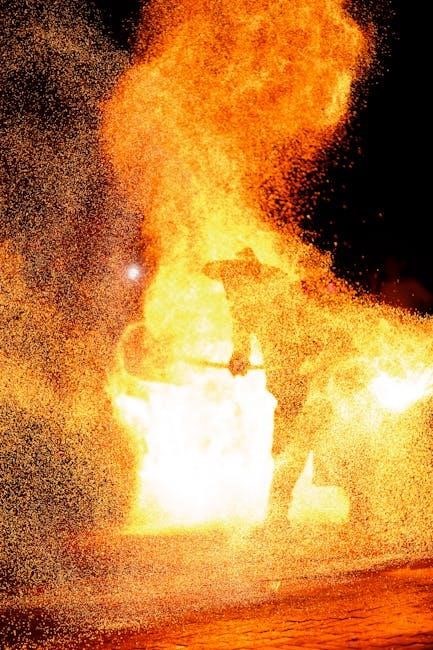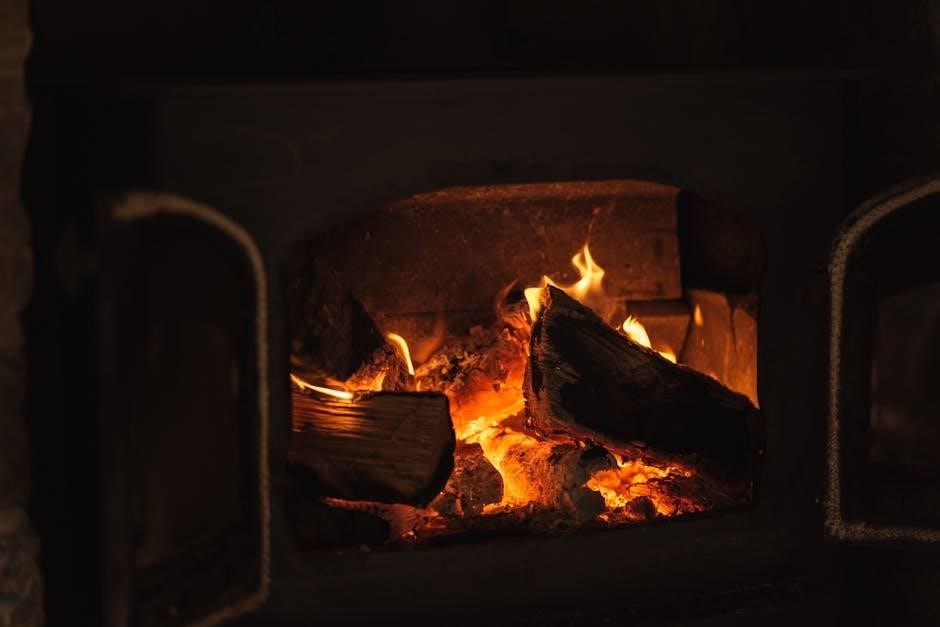
Sublimation printing is a vibrant digital printing technique using heat to transfer dye onto materials. This guide provides essential temperature settings for optimal results across various substrates.
Understanding Heat Press Settings for Sublimation Printing
Heat press settings involve temperature, time, and pressure, which must be balanced for proper sublimation. These settings vary by material and manufacturer guidelines to ensure optimal results.
2.1. Importance of Temperature in Sublimation
Temperature is crucial in sublimation as it converts solid dye into gas, ensuring vibrant prints. Too low, and colors fade; too high, and materials burn. Proper heat activates the ink, making it essential for achieving durable, high-quality designs. Always refer to material-specific guidelines to avoid damage and ensure optimal results. A well-calibrated heat press guarantees consistent and professional outcomes in sublimation printing.
2.2. Basic Heat Press Components: Temperature, Time, and Pressure
Temperature, time, and pressure are key elements in heat press operation. Temperature determines ink activation, time ensures full transfer, and pressure secures contact between substrate and print. Precise control over these factors ensures high-quality sublimation prints. Each material requires specific settings, so understanding their roles is vital for achieving desired results and preventing damage to substrates. Adjustments may be needed based on substrate type and manufacturer recommendations for optimal performance.
Recommended Temperature Ranges for Common Substrates
For sublimation, common substrates like ceramic, glass, and polyester fabric typically require 350-400°F. Metal and stainless steel may need slightly higher temperatures, while wood and MDF also fall within similar ranges. These settings ensure proper dye transfer and prevent damage, optimizing print quality across various materials.
3.1. Ceramic and Glass
Ceramic and glass substrates typically require a temperature range of 350-400°F (175-204°C) for optimal sublimation results. Pressing time varies between 150-300 seconds, depending on the thickness and material type. High pressure (around 40 PSI) is recommended to ensure proper dye transfer and adhesion. These settings help prevent cracking or damage while achieving vibrant, long-lasting colors. Always pre-test to avoid overheating, as this can cause warping or discoloration on delicate surfaces.
3.2. Polyester Fabric
Polyester fabric is a popular choice for sublimation, requiring a temperature of 200-205°C (392-401°F) and a press time of 35-40 seconds. Medium pressure is ideal for even dye transfer. Higher temperatures ensure vibrant colors but risk fabric damage. Always pre-wash polyester to remove finishes that may block dye. These settings promote long-lasting, vibrant prints. Testing on small samples is recommended to achieve optimal results and avoid underheating or overheating issues.
3.3. Metal and Stainless Steel
Metal and stainless steel substrates require a temperature of 400°F (204°C) with press times ranging from 60 to 80 seconds. High pressure, typically 40 psi, is essential for optimal dye transfer. These settings ensure vibrant, durable prints on items like tumblers or custom metal designs. Always consult manufacturer guidelines for specific metal types. Test prints are recommended to avoid overheating and ensure proper adhesion, resulting in professional-grade sublimation results on metal surfaces.
3.4. Wood and MDF
Wood and MDF substrates typically require a temperature of 360-400°F (182-204°C) with press times between 40-90 seconds. Medium to high pressure (around 40 psi) ensures proper dye penetration. For MDF, 400°F for 80-90 seconds is ideal, while plywood may need 60-70 seconds at the same temperature. Always test prints to avoid overheating and ensure vibrant, long-lasting results on wooden surfaces. Consult manufacturer guidelines for specific wood types to achieve the best sublimation outcomes.

Time and Pressure Settings for Optimal Results
Optimal sublimation results require precise time and pressure settings. Typical press times range from 35 to 300 seconds, with pressures between 30 to 40 psi, varying by material.
4.1. Press Time Variations Based on Material
Press time varies significantly depending on the substrate. Polyester fabrics typically require 35-40 seconds, while ceramic mugs need 150-300 seconds. Metals and stainless steel tumblers usually take 60-80 seconds, and wood or MDF boards require 40-80 seconds. These durations ensure proper heat penetration and dye sublimation without overheating. Always consult the manufacturer’s guidelines for specific materials to achieve the best results and prevent damage.
4.2. Pressure Recommendations for Different Surfaces
Pressure settings vary depending on the material. Polyester fabrics and soft surfaces require medium pressure (around 40 PSI), while harder materials like ceramic mugs and metal tumblers need higher pressure (up to 50 PSI). Wood and MDF boards typically require consistent medium to high pressure to ensure even heat distribution. Proper pressure ensures a vibrant transfer without damaging the substrate. Always refer to the manufacturer’s guidelines for specific surface recommendations.

Troubleshooting Common Sublimation Issues
Common issues in sublimation include overheating, underheating, and ink bleeding. Adjusting temperature, time, and pressure settings can resolve these problems. Always consult manufacturer guidelines for optimal results.
5.1. Overheating and Underheating Problems
Overheating can cause colors to fade or ink to burn, while underheating may result in dull prints or incomplete transfers. Monitor temperature settings closely, ensuring they align with substrate requirements. For example, ceramic mugs typically require 350-400°F for 150-300 seconds, while polyester fabric needs 200-205°C for 35-40 seconds. Adjusting press time and temperature can resolve these issues. Always test settings on small areas before final printing to avoid wasted materials and ensure desired results.
5.2. Adjusting Settings for Better Print Quality
Optimizing heat press settings is crucial for achieving high-quality sublimation prints. Adjusting temperature between 350-400°F ensures vibrant colors without burning. Time varies from 35-40 seconds for fabrics to 150-300 seconds for ceramics. Pressure should be set according to material thickness, typically 40 psi for fabrics. Testing on small areas helps verify settings. Always consult manufacturer guidelines for specific substrates to ensure optimal results.
Manufacturer Guidelines and Safety Precautions
Always follow manufacturer instructions for heat press settings and safety. Pre-test settings to ensure compatibility. Wear protective gear and maintain proper ventilation to avoid injury or fumes inhalation.

6.1. Referencing Manufacturer Instructions
Consulting the manufacturer’s guidelines is crucial for optimal sublimation results. Each heat press model may have specific temperature and time recommendations. Always refer to the provided manual for exact settings, as deviations can lead to subpar prints or damage. Testing with sample materials ensures compatibility and desired outcomes, aligning with the manufacturer’s suggested parameters for various substrates like fabric, ceramic, or metal. This step ensures consistency and minimizes errors during the sublimation process.
6.2. Safety Tips for Heat Press Operation
Operating a heat press requires caution to avoid accidents. Always wear heat-resistant gloves and ensure the press is placed on a stable, heat-resistant surface. Keep children and pets away. Avoid overheating materials, as they may release harmful fumes. Proper ventilation is essential to prevent inhaling sublimation ink vapors. Never leave the press unattended while in use. Regularly inspect cables and heating elements for damage. Store the press on a cool surface after use to prevent accidental burns or fires. Always unplug it when not in operation.

Future Trends in Sublimation Heat Press Technology
Advancements include smart heat presses with AI-driven temperature control, automation, and advanced sensors for real-time monitoring. These innovations aim to enhance efficiency and print consistency across materials.
7.1. Advanced Temperature Control Systems
Future heat presses may feature precision temperature control systems, utilizing advanced sensors and AI for real-time adjustments. These systems will optimize heat distribution, ensuring consistent sublimation across materials; Energy efficiency and reduced risk of overheating are expected benefits. Manufacturers are also exploring integration with smart devices for remote monitoring, enhancing user convenience. These innovations aim to streamline the sublimation process, making it more accessible and reliable for both professionals and hobbyists.
7.2. Smart Heat Presses and Automation
Smart heat presses are emerging with automation features like preset settings for materials and auto-shutoff. They integrate Wi-Fi connectivity, allowing users to control presses via smartphones. AI-driven systems predict optimal settings, reducing trial and error. Automation enhances efficiency, enabling batch processing with minimal supervision. These advancements aim to simplify sublimation, ensuring high-quality results while minimizing manual intervention. The future of heat pressing looks seamless, with technology driving precision and productivity for creators and businesses alike.
Mastering sublimation requires testing and adherence to guidelines. Always experiment, follow manufacturer instructions, and optimize settings for consistent results. Success lies in precision and creativity.
8.1. Best Practices for Consistent Results
For consistent sublimation results, ensure accurate temperature and time settings. Preheat the press, use high-quality materials, and test prints. Calibrate equipment regularly and follow manufacturer guidelines. Maintain even pressure and clean the press bed. Store inks and papers in a cool, dry place. Document successful settings for future reference. Experiment on small areas first to avoid waste. Attention to detail ensures vibrant, long-lasting designs. Consistency is key to professional-quality output.
8.2. Encouraging Experimentation and Testing
Experimentation is key to mastering sublimation printing. Test different temperature, time, and pressure settings on small-scale samples to refine results. Conduct trial runs to identify optimal conditions for specific materials. Start with manufacturer-recommended settings and adjust incrementally. Documenting outcomes ensures reproducibility and minimizes waste. Encourage creativity by exploring unique substrates and techniques. Regular testing fosters improvement and adaptability, ensuring high-quality, customized designs. Embrace trial and error as a pathway to innovation and success in sublimation printing.